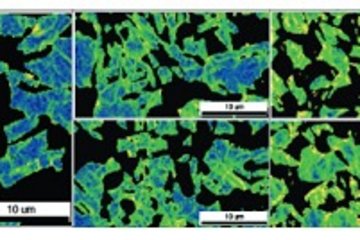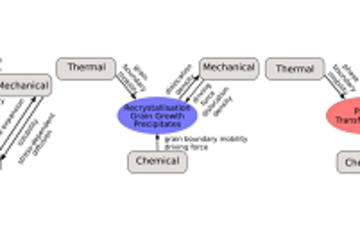All genres
641.
Journal Article
Shear-induced anisotropic decay of correlations in hard-sphere colloidal glasses. EPL - Europhysics Letters 100, pp. 56001-p1 - 56001-p6 (2012)
642.
Journal Article
Characterization of thin anodic oxides of Ti–Nb alloys by electrochemical impedance spectroscopy. Electrochimica Acta 82, pp. 324 - 332 (2012)
643.
Journal Article
Exploring the p-n junction region in Cu(In,Ga)Se2 thin-film solar cells at the nanometer-scale. Applied Physics Letters 101 (18), pp. 181603-1 - 181603-5 (2012)
644.
Journal Article
Theory-Guided Materials Design of Multi-Phase Ti–Nb Alloys with Bone-Matching Elastic Properties. Materials 5 (10), pp. 1853 - 1872 (2012)
645.
Journal Article
Elastic properties of face-centred cubic Fe–Mn–C studied by nanoindentation and ab initio calculations. Acta Materialia 60 (17), pp. 6025 - 6032 (2012)
646.
Journal Article
Multistage strain hardening through dislocation substructure and twinning in a high strength and ductile weight-reduced Fe–Mn–Al–C steel. Acta Materialia 60 (16), pp. 5791 - 5802 (2012)
647.
Journal Article
Precipitation Behavior of V and/or Cu Bearing Middle Carbon Steels. Tetsu-To-Hagane/Journal of the Iron and Steel Institute of Japan 98 (8), pp. 434 - 441 (2012)
648.
Journal Article
On the Correlation Between Thermal Cycle and Formation of Intermetallic Phases at the Interface of Laser-Welded Aluminum-Steel Overlap Joints. Advanced Engineering Materials 14 (7), pp. 464 - 472 (2012)
649.
Journal Article
The relation between ductility and stacking fault energies in Mg and Mg–Y alloys. Acta Materialia 60 (6-7), pp. 3011 - 3021 (2012)
650.
Journal Article
Polycrystal model of the mechanical behavior of a Mo–TiC30 vol.% metal–ceramic composite using a three-dimensional microstructure map obtained by dual beam focused ion beam scanning electron microscopy. Acta Materialia 60 (4), pp. 1623 - 1632 (2012)
651.
Journal Article
Non-crystallographic shear banding in crystal plasticity FEM simulations: Example of texture evolution in α-brass. Acta Materialia 60 (3), pp. 1099 - 1115 (2012)
652.
Journal Article
Heterogeneous Shear in Hard Sphere Glasses. Physical Review Letters 108 (9), pp. 098301-1 - 098301-5 (2012)
653.
Journal Article
Microstructural evolution of a Ni-based superalloy (617B) at 700 °C studied by electron microscopy and atom probe tomography. Acta Materialia 60 (4), pp. 1731 - 1740 (2012)
654.
Journal Article
On the Effect of Manganese on Grain Size Stability and Hardenability in Ultrafine-Grained Ferrite/Martensite Dual-Phase Steels. Metallurgical and Materials Transactions A 43A, pp. 37 - 46 (2012)
655.
Journal Article
Atom-Probe Tomography of compound semiconductors for photovoltaic and light-emitting device applications. Microscopy Today 20 (3), pp. 18 - 24 (2012)
656.
Journal Article
Adiabatic temperature increase associated with deformation twinning and dislocation plasticity. Acta Materialia 60 (9), pp. 3994 - 4004 (2012)
657.
Journal Article
Strukturhierarchie, chemische Zusammensetzung und mechanische Eigenschaften von Haifischzähnen. BioNanoMaterials 13 (57) (2012)
658.
Journal Article
Correlation of structure, composition and local mechanical properties in the dorsal carapace of the edible crab Cancer pagurus. 11, pp. 766 - 776 (2012)
659.
Journal Article
Study of deformation twinning and planar slip in a TWIP steel by Electron Channeling Contrast Imaging in a SEM. Materials Science Forum 702 - 703, pp. 523 - 529 (2012)
660.
Journal Article
Dislocation density measurement by electron channeling contrast imaging in a scanning electron microscope. Scripta Materialia 66, pp. 343 - 346 (2012)











